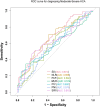Systemic immune-inflammation index predicts acute histologic chorioamnionitis pathologic staging and neonatal respiratory distress syndrome in women with preterm premature rupture of membranes: a retrospective cohort study
- PMID: 41257672
- PMCID: PMC12628863
- DOI: 10.1186/s12884-025-08446-7
Systemic immune-inflammation index predicts acute histologic chorioamnionitis pathologic staging and neonatal respiratory distress syndrome in women with preterm premature rupture of membranes: a retrospective cohort study
Abstract
Background: We aimed to investigate the predictive value of the systemic immune-inflammation index (SII) for acute histologic chorioamnionitis (HCA) pathologic staging and neonatal respiratory distress syndrome (NRDS) in women with preterm premature rupture of membranes (PPROM).
Methods: We retrospectively evaluated 135 pregnant women with PPROM at a gestational age of 20+ 0 ~ 33+ 6 weeks. The women based on placental histopathology were categorized into No/Mild and Moderate-Severe group. Multivariate logistic regression analysis was conducted to assess the factors influencing Moderate-Severe HCA and to develop a nomogram model. The model was evaluated using receiver operating characteristic (ROC) curves, calibration curves, and decision curves.
Results: Of the 135 women, 63 were included in the No/Mild HCA group and 72 were included in the Moderate-Severe HCA group. Among inflammatory markers, the SII showed the highest area under the curve (AUC) for predicting Moderate-Severe HCA. The Moderate-Severe HCA group displayed lower gestational age at PPROM, lower birth weight and higher SII compared with the No/Mild HCA group. Multivariate logistic regression analysis identified SII, C-reactive protein (CRP) and gestational age at PPROM as independent prognostic factors affecting Moderate-Severe HCA, our nomogram model incorporating these three factors had the highest AUC of 0.853 (95%CI: 0.788–0.918), followed by gestational age at PPROM, CRP and SII with AUCs of 0.786 (95%CI: 0.705–0.764), 0.697 (95%CI: 0.619–0.776) and 0.674 (95%CI: 0.584–0.764), respectively. The sensitivity and specificity of the nomogram model, gestational age at PPROM, CRP, and SII were 0.708 and 0.889, 0.681 and 0.714, 0.653 and 0.905, 0.583 and 0.667, respectively. The model showed well-fitted calibration curves and the clinical benefit. The model and birth weight are independent risk factors affecting NRDS.
Conclusions: SII was identified as an inflammatory biomarker in both Moderate-Severe HCA and NRDS can serve as a useful tool to guide clinical treatment decisions.
Keywords: Acute histologic chorioamnionitis; Neonatal respiratory distress syndrome; Pathological stages; Systemic immune-inflammation index.
Conflict of interest statement
Declarations. Ethics approval and consent to participate: The study received approval from the Ethics Committee of the Xiaolan People’s Hospital of Zhongshan (approval number: ZSXL-LL2024-012). In this study, due to its retrospective nature, informed consent was waived with the approval of the Ethics Committee of the Xiaolan People’s Hospital of Zhongshan. Consent for publication: Not applicable. Competing interests: The authors declare no competing interests.
Figures




References
-
- Henderson JJ, McWilliam OA, Newnham JP, Pennell CE. Preterm birth aetiology 2004–2008. Maternal factors associated with three phenotypes: spontaneous preterm labour, preterm pre-labour rupture of membranes and medically indicated preterm birth. J Matern Fetal Neonatal Med. 2012;25:642–7. - PubMed
-
- Cobo T, Kacerovsky M, Palacio M, Hornychova H, Hougaard DM, Skogstrand K, et al. A prediction model of histological chorioamnionitis and funisitis in preterm prelabor rupture of membranes: analyses of multiple proteins in the amniotic fluid. J Matern Fetal Neonatal Med. 2012;25:1995–2001. - PubMed
LinkOut - more resources
Full Text Sources
Research Materials
Miscellaneous

